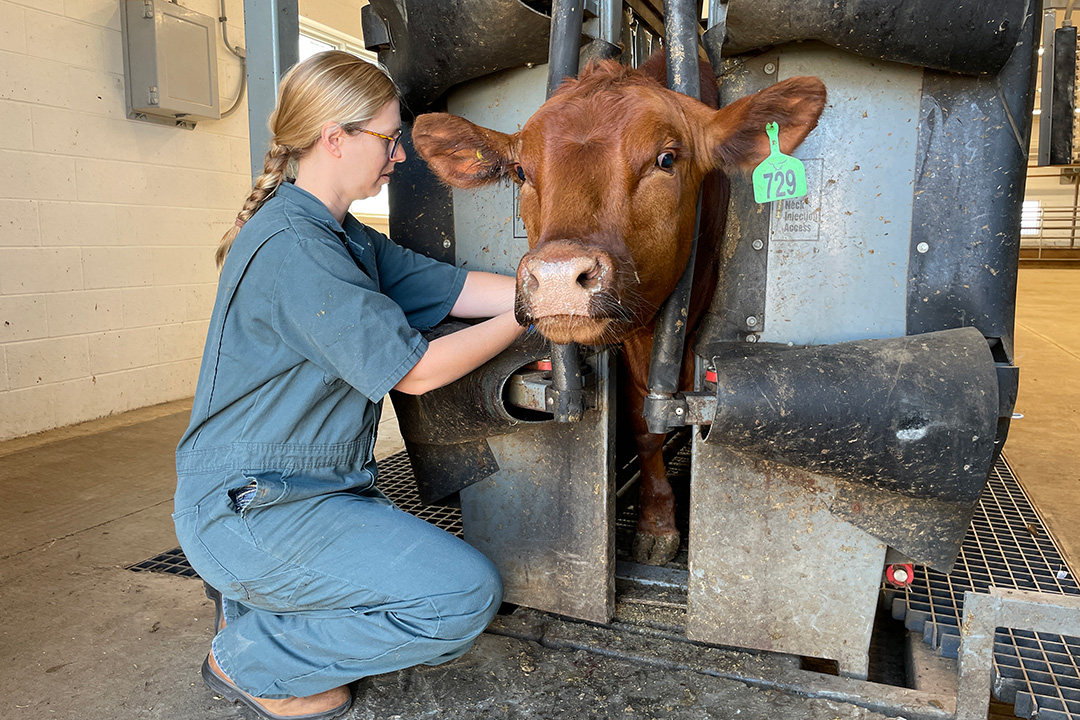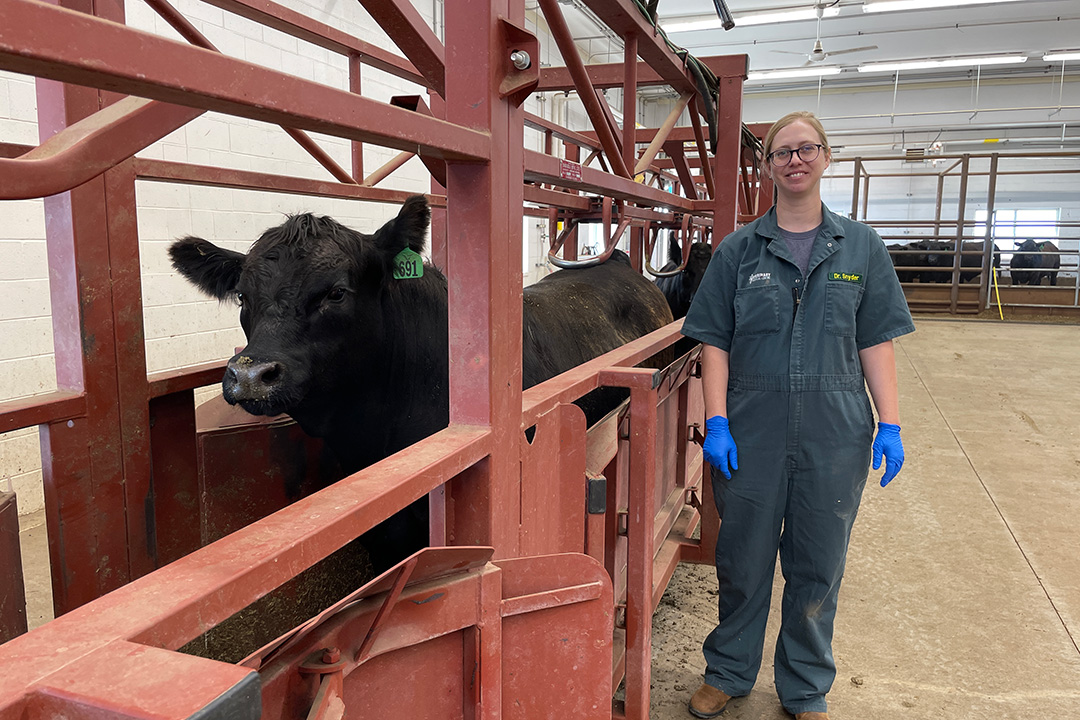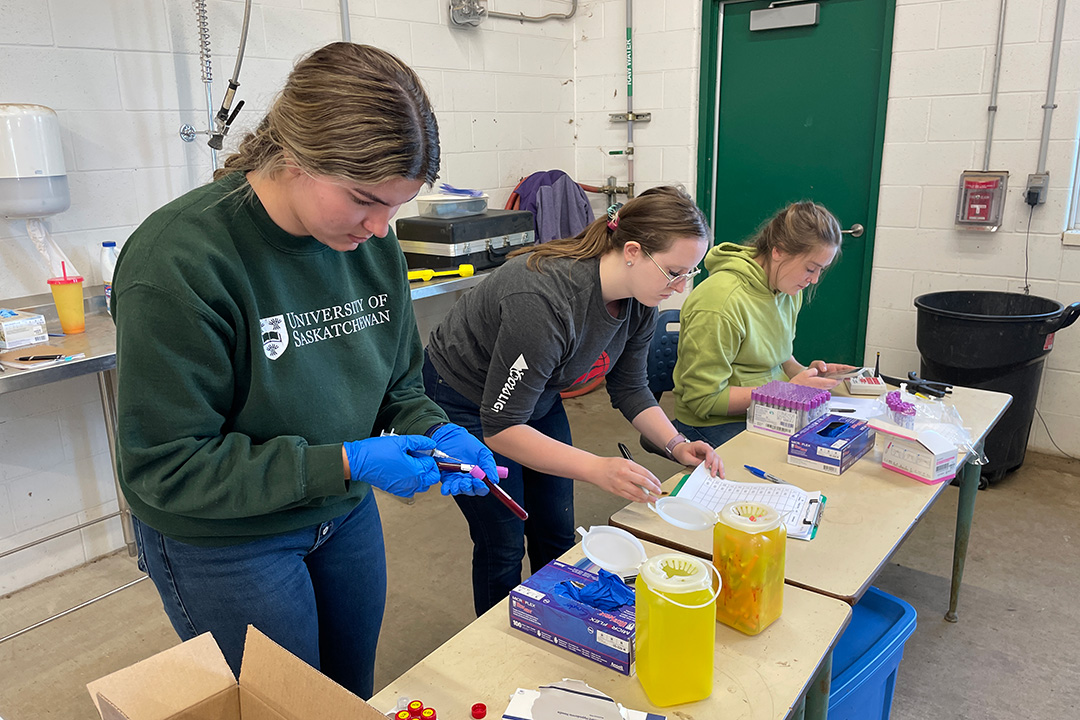
Respiratory diseases in cattle pique veterinarian’s curiosity
Dr. Emily Snyder’s curiosity over the years has led her to a place where improving the health of beef cattle is of utmost importance.
By Lana Haight“My big motivation is my own curiosity. I’m interested in knowing why animals get sick and what’s the cause of it,” says Snyder (DVM, PhD), an assistant professor in the Department of Large Animal Clinical Sciences at the University of Saskatchewan’s Western College of Veterinary Medicine (WCVM).
Snyder, who is from Iowa, didn’t grow up around cattle but developed her interest in animals during high school. One of her teachers encouraged her to use her skills as a debater in an extracurricular activity called Future Farmers of America where she learned to judge livestock — including bulls, heifers and steers. In competitions, Snyder and other members of her school team would rank four animals in each group. They would have only a couple of minutes to prepare a formal defence or rationale for their decisions. She continued to compete at the college level where she studied animal science.
“This is going to sound bananas. It’s not a thing in Canada, but in the U.S., it’s a really big deal. It’s like a full-time sport,” says Snyder. “At college, we practised every single day and on the weekends. It’s really competitive. Everything all tied together: my interest in livestock judging and my interest in animal science.”

“It taught me a lot about evaluating livestock, looking at animals, understanding what they look like, what normal looks like, what healthy animals look like and seeing differences. It also gave me a lot of experience with public speaking and giving formal reasons. And then I learned time management.”
After Snyder completed veterinary college at Iowa State University in 2011, she worked for two years in private mixed animal practice in the Midwestern United States. She returned to school and received a master’s degree in food animal medicine in 2016 and a PhD degree in 2020 from the University of Georgia. In January 2021, Snyder moved to Saskatoon and began her position at the veterinary college.
Her interest in antimicrobial resistance and respiratory diseases in beef cattle began when she was conducting research at the University of Georgia involving stocker cattle and strains of Mannheimia haemolytica that were resistant to antimicrobial treatments.
When the weaned calves arrived at the farm in Georgia, the animals had very little resistance to an antimicrobial used to fight the bacteria that cause bovine respiratory disease. Yet, 10 to 12 days later, the bacteria were not only resistant to the antimicrobial the cattle initially received, they were resistant to almost all drugs that would be used to treat the disease.
“In this particular case, it makes it really difficult to treat animals when they get sick because we don’t have any drugs that work anymore,” says Snyder.
One of Snyder’s current research projects involves feedlot cattle at USask’s Livestock and Forage Centre of Excellence (LFCE), south of Clavet. She’s looking at a different respiratory disease called atypical interstitial pneumonia (AIP) that causes inflammation in the lining of the lungs. Little is known about the cause of the disease in feedlot cattle while treatments are limited and not effective.
A similar disease in humans is called acute respiratory distress syndrome and high serotonin levels are believed to be a possible contributor to the cause.

Snyder is working to establish the normal serotonin level in healthy feedlot steers and heifers, the first step to determining if abnormal serotonin levels contribute to this type of pneumonia in cattle. Starting in May 2023 and continuing to the end of August, she’s testing the serotonin levels in 42 steers and 40 heifers at the LFCE Beef Cattle Research and Teaching Unit.
Atypical interstitial pneumonia is not as common as bovine respiratory disease, but the impact is significant in terms of animal health and producer profitability.
“AIP usually strikes in the late feeding period when we have fat cattle that we’ve spent all this time feeding in the feedlot,” says Snyder. “They are probably going to slaughter in 100 days or less, and then they get this disease and suddenly die. The animals suffer. They are sick and we can’t treat them effectively.”
Synder’s curiosity is piqued, and she wonders if acidosis or other issues with the rumen’s bacteria contributes to abnormal serotonin levels that create the right environment for the lungs to become inflamed, resulting in this type of pneumonia.
But that’s for another day. First things first, she says.
“We have to understand what normal is before we can determine if elevated serotonin is a factor.”
Snyder’s research projects take her in two very different directions with the same end goal: finding answers and providing more information for diseases that aren’t fully understood. As she fills in those gaps, she’s hoping to help cattle producers who operate feedlots improve the health and well-being of their animals while ensuring those producers remain financially viable.
This story was originally posted on the USask Livestock and Forage Centre of Excellence (LFCE) website. Click here to visit the LFCE site.
